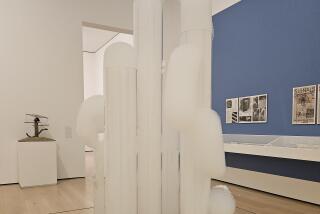ART : Images of Behavior : Mike Kelley’s Work, Neglected at Laguna Show, Digs Deep Into Youth Rebellion
“Kustom Kulture: Von Dutch, Ed ‘Big Daddy’ Roth, Robert Williams & Others,” last summer’s big show at the Laguna Art Museum, was a ground-breaking exhibition that lingers in the mind. Its major appeal was the novelty of seeing a show primarily devoted to irreverent imagery that taps into teen-age male preoccupations with speed, violence, power, gross-out situations and automotive craftsmanship.
But the “& Others” portion of the exhibition--a sampling of contemporary art that addresses aspects of the “car culture” mentality--unfortunately came across as a dutiful postscript that didn’t do full justice to the cultural perspective offered by key postmodern artists.
Mike Kelley is one of these artists, and the revelatory exhibition of his work at the Los Angeles County Museum of Art (through Sept. 11) suggests that a greater emphasis on his sensibility would have given “Kustom Kulture” a welcome ballast.
Although his art is pointedly anti-macho and bolstered by a sophisticated intellectual background, it is rooted in the same state of adolescence that propelled “Kustom Kulture.”
However, instead of catering to teen-age fantasies or rendering tongue-in-cheek fantasy versions ( a la Robert Williams), Kelley uses pop-derived--and sometimes deeply taboo--imagery to get at conflicted or buried feelings about such touchy subjects as family life, religion and body functions.
Had “Kustom Kulture” devoted more wall space to Kelley’s art and more catalogue space to a discussion of his work, the show would have made a more persuasive case for the deeper significance of art based on the transgressive attitudes of youth.
*
In Kelley’s unique perspective, the most banal everyday things--from Bible illustrations to cartoons, from stuffed animals to hobbyist manuals--mirror the tremendous gap between imperfect real life and the ideals and archetypes that are part of our cultural fabric.
Williams has described “the purest form of art” as “simple visual interest--to look at what you find yourself driven to see. Higher notions of art tend to confine art with lofty moral restrictions.”
But Kelley’s art is intensely involved with moral issues even as it thumbs its nose at the strictures of modernist aesthetes, liberal do-gooders and polite society.
Born in 1954 in Detroit (Motor City), Kelley grew up in a working-class suburb. A generation--and half a continent--removed from the trio of car-culture artists (he didn’t move to California until 1976), he was influenced in his youth by a mixture of counterculture, popular culture, traditional mores and art. They included proto-punk musicians Iggy and the Stooges, TV, Japanese horror movies, Catholic school, the avant-garde Fluxus group and the performance art and installations of Joseph Beuys and Allan Kaprow.
By the time Kelley became a teen-ager in the ‘60s, the car culture stuff was available to him as a consumer--Von Dutch’s creative car painting (flames, flying eyeballs), Roth’s Rat Fink caricatures and Williams’ Zap Comix drawings. The fascinating thing is that Kelley seems to have absorbed all visual information in the same questioning way, not distinguishing between “high” and “low” art.
*
While the Kustom Kulture trio primarily was interested in the way art looks , Kelley preferred to try to figure out how art (or any imagery) behaves . In a quote in the LACMA exhibit catalogue, he says that years ago he began wondering why Willem de Kooning’s Abstract Expressionist distorted figures “don’t have the same meaning” as those by Mad magazine cartoonist Basil Wolverton.
“I probably like (Wolverton) for the same reason I like De Kooning,” Kelley said, “but he’s funny and De Kooning’s not funny. I started thinking about how something could be funny and not funny at the same time, depending on the context it was put in.”
For some reason, the work selected to represent Kelley in “Kustom Kulture” was the painting “Infinite Expansion” that was part of his 1984 performance piece “The Sublime.” In the painting, a meandering, organic pattern flows outward from a blank central square. That blankness is at the heart of “the infinite”--a concept with no actual counterpoint in reality.
*
Although “Infinite Expansion” displays Kelley’s typical method of presenting a daunting philosophical issue in a deliberately debased format (in this case, a gigantic notebook doodle), numerous other works of his might have been more relevant to the sophomoric high jinks of “Kustom Kulture.”
For example, the source for Kelley’s curiously minimal “garbage” drawings was Sad Sack comics, the strip about the Army private constantly humiliated by his superiors and often assigned to KP. Remove all the figures and speech balloons from the strip, and the “landscape” turns out to be the cartoonist’s scribbled shorthand for garbage.
By using this “throwaway” detail as the sole imagery in a series of drawings, Kelley located the ultimate symbol of human degradation and feelings of worthlessness at the heart of a popular, nationally syndicated cartoon strip. By beaming a relentless intellect on the banal corners of contemporary life, Kelley locates the confused, cynical and resentful adolescent in us all.
* “Mike Kelley,” organized by the Whitney Museum of American Art in New York, continues through Sept. 11 at the Los Angeles County Museum of Art, 5905 Wilshire Blvd., Los Angeles. Hours: 10 a.m. to 5 p.m. Wednesdays and Thursdays; 10 a.m. to 9 p.m. Fridays; 11 a.m. to 6 p.m. Saturdays and Sundays. Admission: $6 for adults; $4 for students over 18 and seniors over 62; $1 for children and younger students; free for children 5 and under. (213) 857-6000.
More to Read
The biggest entertainment stories
Get our big stories about Hollywood, film, television, music, arts, culture and more right in your inbox as soon as they publish.
You may occasionally receive promotional content from the Los Angeles Times.










